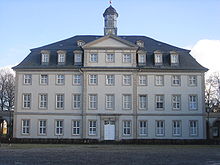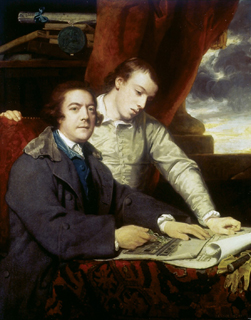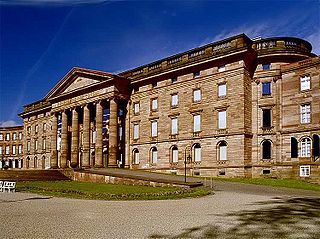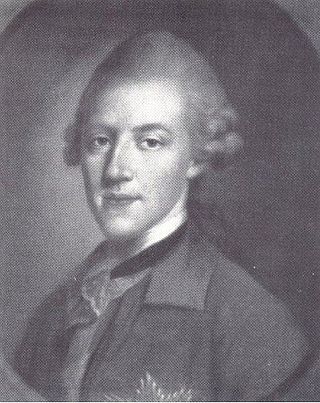


Simon Louis du Ry (13 January 1726 in Kassel - 23 August 1799 in Kassel) was a classical architect. [1]



Simon Louis du Ry (13 January 1726 in Kassel - 23 August 1799 in Kassel) was a classical architect. [1]
Simon Louis du Ry was the son of the Huguenot architect Charles du Ry and grandson of Paul du Ry of Kassel. He was from a French refugee family, who after the revocation of the Edict of Nantes by Louis XIV had to leave France and went to Hessen under Landgrave Charles. After beginning studies in Stockholm, Sweden, from 1746 to 1748 he was disappointed in his teacher Carl Hårleman and left for Paris to attend the architectural school of Jacques-François Blondel (École des Art) in 1748–52. After further educational trips in France and to Italy he returned to Kassel, Germany and became chief architect on the court after the death of this father. In 1766 he was installed as professor architectura civilis at the Collegium Carolinum in Kassel. [2]
Under Frederic of Hessen he was responsible for the transformation of the old and partly destroyed town of Kassel into a modern capital. [3] The Königsplatz (Kings square) and the Friedrichsplatz (Frederics square) remain the main squares in Kassel.[ citation needed ]
Simon Louis du Ry designed and executed many castles and palaces including:

Kassel is a city on the Fulda River in northern Hesse, in central Germany. It is the administrative seat of the Regierungsbezirk Kassel and the district of the same name and had 201,048 inhabitants in December 2020. The former capital of the state of Hesse-Kassel has many palaces and parks, including the Bergpark Wilhelmshöhe, which is a UNESCO World Heritage Site. Kassel is also known for the documenta exhibitions of contemporary art. Kassel has a public university with 25,000 students (2018) and a multicultural population.

Robert Adam was a British neoclassical architect, interior designer and furniture designer. He was the son of William Adam (1689–1748), Scotland's foremost architect of the time, and trained under him. With his older brother John, Robert took on the family business, which included lucrative work for the Board of Ordnance, after William's death.

Sir William Chambers was a Swedish-Scottish architect, based in London. Among his best-known works are Somerset House, and the pagoda at Kew. Chambers was a founder member of the Royal Academy.

James Paine (1717–1789) was an English architect. He worked on number of country houses such as Chatsworth House, Thorndon Hall and Kedleston Hall.

Princess Louise of Denmark and Norway was born to Frederick V of Denmark and Louise of Great Britain. Her eldest daughter, Marie of Hesse-Kassel, was the wife of Frederick VI of Denmark.

Frederick II was Landgrave of Hesse-Kassel from 1760 to 1785. He ruled as an enlightened despot, and raised money by renting soldiers to Great Britain to help fight the American Revolutionary War. He combined Enlightenment ideas with Christian values, cameralist plans for central control of the economy, and a militaristic approach toward international diplomacy.

Schloss Wilhelmshöhe is a Neoclassical palace located in Bad Wilhelmshöhe, a part of Kassel, Germany. It was built for Landgrave Wilhelm (William) IX of Hesse in the late 18th century. Emperor Wilhelm II made extensive use of it as a summer residence and personal retreat.

Prince Charles of Hesse-Kassel was a cadet member of the house of Hesse-Kassel and a Danish general field marshal. Brought up with relatives at the Danish court, he spent most of his life in Denmark, serving as royal governor of the twin duchies of Schleswig-Holstein from 1769 to 1836 and commander-in-chief of the Norwegian army from 1772 to 1814.

Wabern is a municipality in the Schwalm-Eder district in northern Hesse, Germany. It lies on the Main-Weser Railway between Kassel and Frankfurt. From Wabern, the Edersee Railway runs to Bad Wildungen.

Bergpark Wilhelmshöhe is a landscape park in Kassel, Germany. The area of the park is 2.4 square kilometres, making it the largest European hillside park, and second largest park on a hill slope in the world. Construction of the Bergpark, or "mountain park", began in 1689 at the behest of the Landgraves of Hesse-Kassel and took about 150 years. The park is open to the public today. Since 2013, it has been a UNESCO World Heritage Site because of its monumental Baroque architecture and its unique fountains and water features.

The Fridericianum is a museum in Kassel, Germany. Built in 1779, it is one of the oldest public museums in Europe. Since 1955 the quinquennial art festival documenta has been centred on the site, with some artworks displayed on Friedrichsplatz, in front of the building.

Frederick V Louis William Christian, Landgrave of Hesse-Homburg was from 1751 to his death landgrave of Hesse-Homburg.
Louis Remy de la Fosse was a French architect during the Baroque period, who worked primarily in Germany. Until 1705, he was draftsman in the studio of master builder Johann Friedrich Eosander in Berlin. From 1706 to 1709, Fosse was architect at the court of Elector Georg Ludwig in Hanover and later castle planner in Schlitz and Kassel. From 1711 to 1714 he was court architect in Hanover and afterwards senior engineer in the service of Ernest Louis, Landgrave of Hesse-Darmstadt. In 1717, he build the Orangerie in Darmstadt. Fosse was commissioned to completely redesign the Residential Palace Darmstadt. Due to lack of funds, only the main front and one wing of the large complex were realized.

Bellevue Palace in Kassel was built in 1714 for Charles I, Landgrave of Hesse-Kassel. Originally the building served as an Observatory. It became a residence, and then part of Bellevue Castle, which was later destroyed. Until its closure for structural reasons in 2009, the building housed a museum devoted to the Grimm Brothers, which has now moved to the Grimmwelt Kassel.

Jean Paul du Ry was a French architect and Huguenot refugee who was responsible for a number of baroque buildings in Kassel, Hesse, Germany.
The following is a timeline of the history of the city of Kassel, Germany.
Bieling Architekten is a German architecture firm located in Kassel, Hesse, with another office in Hamburg. Founded by Josef Bieling in 1955, the firm has projects throughout Germany. His son Thomas Bieling. a director since 2011, runs the company as a group of independent architects. Earlier names included Architekturbüro Josef Bieling, Bieling & Bieling Architekten, and Bieling & Bieling. They designed apartment buildings and offices, and became known for winning competitions for new quarters, such as Waidmarkt in Cologne and Wallhöfe in Hamburg.

The Collegium Carolinum was a scientific institution in Kassel, Germany. It was founded in 1709 by Charles I, Landgrave of Hesse-Kassel and closed after the 1785 death of Frederick II, Landgrave of Hesse-Kassel. The Ottoneum housed most of its activities. However, a new anatomical theatre, the first in Germany, was used by Samuel Thomas von Sömmerring.